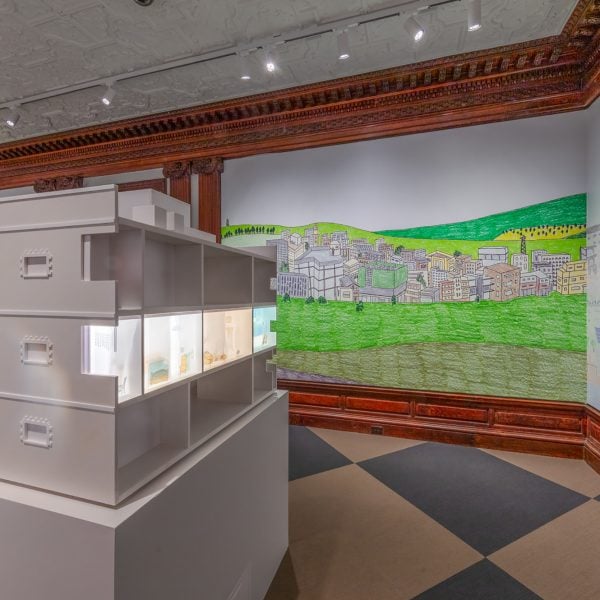Data journalist and illustrator Mona Chalabi has worked with architecture studio Situ to examine the proposed international crime of domicide in Patterns of Life, an installation at the Smithsonian Design Triennial at New York’s Cooper Hewitt museum.
Presented under the triennial’s theme of “Making Home“, Patterns of Life explores the impacts of the systematic destruction of housing by focusing on three real-world examples, represented by three architectural models.
The models recreate in dimensionally precise detail the homes of Osman and his wife in Manbij, Syria, damaged in 2016; Basim and his family in Mosul, Iraq, destroyed in 2015; and an unnamed woman and her son in Gaza, Palestine, destroyed in 2023.
Alongside the models, Chalabi‘s illustrations both situate the homes within their wider cities and provide a window into the lives that were lived within.
Chalabi conceived the installation in collaboration with Situ Research, a wing of Brooklyn-based practice Situ, to put a human face on the widespread destruction in overseas conflicts that the public sees in the media.
She was first approached by the triennale in 2023 and initially began developing a work around US housing and inequality before pivoting once the scale of the Israeli offensive in Gaza began to dwarf her other concerns.
There is still a connection to the US, however – all three of the homes featured in the exhibition were destroyed by American munitions, with a direct link proved through Situ’s research.

“A large part of this project was to recast how a lot of these countries are represented in US media,” Situ Research deputy director Gauri Bahuguna told Dezeen. “You’re not really shown these private, intimate moments of domestic life.”
“Another part of that is just this relentless depiction of rubble,” added Chalabi. “The rubble only shows the after – it doesn’t really show you what’s been lost.”
“It’s so hard for us [as viewers] to look at piles and piles of grey concrete broken into stones and to visually be able to construct what was there, whereas a resident of that city will look out and they will see what was there before,” she continued.
The homes in Patterns of Life all have different typologies. Basim’s home in Iraq is the single-family house of someone relatively affluent, while the home in Gaza is a low-rise multi-family residence and Osman’s in Syria is a larger apartment building.

Situ’s fabrication unit constructed the models as accurately as possible based on satellite imagery gathered by Situ Research as well as the photographs and personal testimonies of the participants that Chalabi interviewed.
Inside the models, the team took a more non-literal approach. On one facade, the models are cut to reveal a cross-section of the interior, recreated with an almost dreamlike quality that aims to communicate a feeling of loss.
Here, Chalabi’s illustrations of domestic details remembered by her interviewees – such as books, toys and heirlooms – are presented as digital prints on layers of translucent silk, giving both a sense of three-dimensionality and fragility.
Bahuguna said that this approach arose in an effort to combine architectural models and illustration without entering “doll house territory”.
“There were conversations about, how do you get someone to feel a bit more softness or evoke some sense of domesticity without then veering into the twee?” she said.
“We talked about having 3D objects, but it would have felt too twee or too much like a doll’s house,” added Chalabi. “There needed to be some degree of abstraction.”
“If it was a full replica of the home, you would almost lose sight that this had been destroyed. We wanted to communicate that something has been lost here – this is an attempt to recreate memories, rather than to recreate the home itself,” she continued.
Fragrance also helps to evoke emotion, with peppermint oil in the Syrian home honouring Osman’s memories of mint tea, lavender oil in the Iraqi home nodding to Basim’s garden, and orange oil in the Palestinian home evoking surrounding orchards.

Chalabi and Bahuguna hope that, after walking through many other rooms exploring housing in the USA, visitors to Patterns of Life are drawn to reflect on the country’s connection to these homes overseas and their destruction.
Domicide is not currently a crime under international law, but it has been on the agenda since it was recommended in a 2022 report by the UN Special Rapporteur on the Right to Adequate Housing, Balakrishnan Rajagopal.
The report considers not just the deliberate destruction of homes through military conflict but through urban development or social upheaval as kinds of domicide.
“It felt really important to communicate that domicide isn’t about the destruction of a house, it’s about the destruction of a home,” said Chalabi.
“Under international law, a home is not protected; the only protections that exist reduce home to private property,” added Bahuguna. “But there is something more than just the physical property that is being destroyed.”
The Cooper Hewitt Smithsonian Design Museum’s seventh triennial exhibition, Making Home features a wide range of works, including an installation by The Architecture of Reentry imagining the best way for individuals to reenter communities from prison and an intervention by the Black Artists + Designers Guild restocking the museum’s library.
The photography is by Elliot Goldstein.
The Smithsonian Design Triennial is on show from November 2024 to 10 August 2025 in New York City. For more exhibitions, talks and fairs in architecture and design visit Dezeen Events Guide.
Project credits:
SITU Research team: Gauri Bahuguna, Martina Duque Gonzalez, Sam Rabiyah, Frederick Rapp, Bradley Samuels, Candice Strongwater

